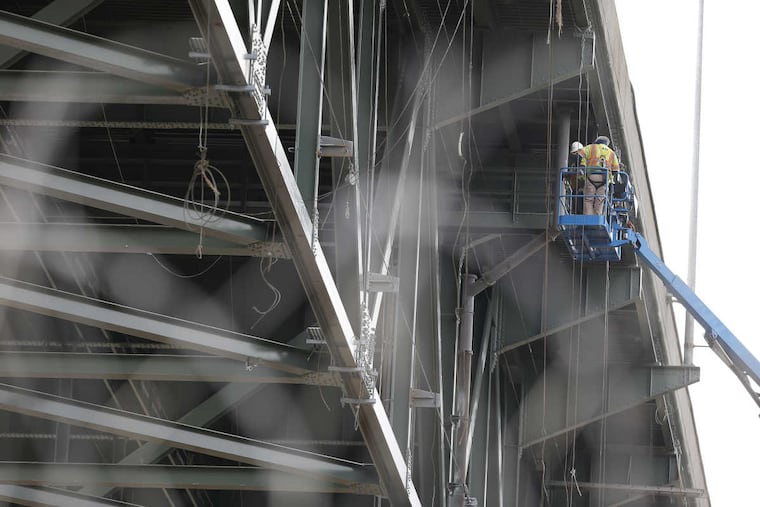Mr. President, where's that infrastructure plan?
PennDOT is working on a long-term, multiphase initiative to rebuild and improve Interstate 95 in the commonwealth. Five major projects to reconstruct I-95 between the Interstate 676 and Cottman Avenue interchanges in Philadelphia are in various stages of design or reconstruction.

Missing in action amid the hoopla on the barely passed House health-care bill and the broadly supported government funding measure is the promised infrastructure package by President Trump.
During a speech in Kenosha, Wis., on April 18, Trump declared that a sweeping change is on the horizon. "Infrastructure. Big infrastructure bill," he said. "Infrastructure is coming, and it's coming fast."
But just a month before, Philadelphia's city planning director, Anne Fadullon, had addressed the National Press Club in Washington about the uncertainty of necessary infrastructure reform. "We have no more information than you do," she said.
While Trump has repeatedly stressed how easy it is to improve infrastructure, his administration has yet to make any substantive legislative proposal.
Carl Weisbrod, New York City's immediate past City Planning Chairman, asserted that "infrastructure has suffered from decades of disinvestment," and confirmed Trump's assertion that "tiles on the ceiling are missing from the Lincoln Tunnel." Weisbrod added, "Bridges and tunnels are in dire need."
Fadullon remarked that she has been eagerly waiting for the Trump administration to subsidize long overdue infrastructure improvements. "I'm cautiously optimistic," she said. "The hope is significant."
Trump had listed Philadelphia infrastructure as a priority during his campaign and the transition, but has remained silent for months. Congressional leadership has likewise stalled on an infrastructure bill, leaving shaky bridges on I-95 vulnerable to empty promises.
Philadelphia's transit renovations are hanging in the balance. The Pennsylvania Department of Transportation's 95 Revive project lacks federal funding, due in part to disagreements between Republicans and Democrats.
PennDOT is working on a long-term, multiphase initiative to rebuild and improve Interstate 95 in the commonwealth. Five major projects to reconstruct I-95 between the Interstate 676 and Cottman Avenue interchanges in Philadelphia are in various stages of design or reconstruction.
Reconstruction of the Girard Avenue interchange alone is not even halfway complete, with costs for the first three stages of this section totaling an estimated $342.3 million. While PennDOT is working on this initiative, the extension still requires authorization from the federal government.
Unlike most political issues, infrastructure improvements have bipartisan appeal, and the president seems interested in following through on the issue. In January, the developing Trump administration compiled a national infrastructure priority list that included "15 bridges on the I-95 extension."
For Fadullon, this is good news. She has expressed a willingness to work with the White House. So far, she said that infrastructure funding has been "federal 15 percent and 65 percent city funding," with the remainder coming from private businesses.
With infrastructure funding supported by the federal government, Fadullon hopes to see lasting economic improvements throughout Philadelphia. In addition to a reliable Northeast Rail corridor, she emphasized the importance of reconnecting the Delaware River waterfront with other areas in the city. And, Fadullon said, better public transit would "improve access to jobs for 75 to 85 percent of workers. It has huge jobs potential."
In February, Trump stated, "I will be asking the Congress to approve legislation that produces a $1 trillion investment in the infrastructure of the United States - financed through both public and private capital - creating millions of new jobs."
Now he must follow through in a concrete way. In a speech at the National Press Club, Senate Minority Leader Chuck Schumer (D., N.Y.) remarked that any infrastructure bill should be paid for "with federal expenditures, as infrastructure has always been, not cutting other programs, not with tax breaks." House Minority Leader Nancy Pelosi has warned: "If it's a tax bill disguised as an infrastructure bill, that's not going to happen."
There are clear precedents of Republicans and Democrats working together to pass a bipartisan bill. In December 2015, at the request of President Barack Obama, Congress passed a $305 billion bill for roads, bridges, and railroads by a vote of 81-16 in the Senate and 359-65 in the House. There has been similar infrastructure legislation during every administration since 1960. Trump must foster that same spirit of cooperation to make 95 Revive a success, ensuring that the $8 billion he outlined for the project in the national infrastructure priority list is allocated.
Infrastructure legislation can pave the way for increased economic productivity and public safety across all 50 states - if prudent legislation trumps partisan differences.
Robert Weiner is a former spokesman for the Clinton and Bush White Houses and the House Government Operations Committee. weinerpublic@comcast.net
Ryan Powers, born in Philadelphia and raised in Moorestown, is a policy analyst at Robert Weiner Associates and Solutions for Change. ryanwillpowers@gmail.com